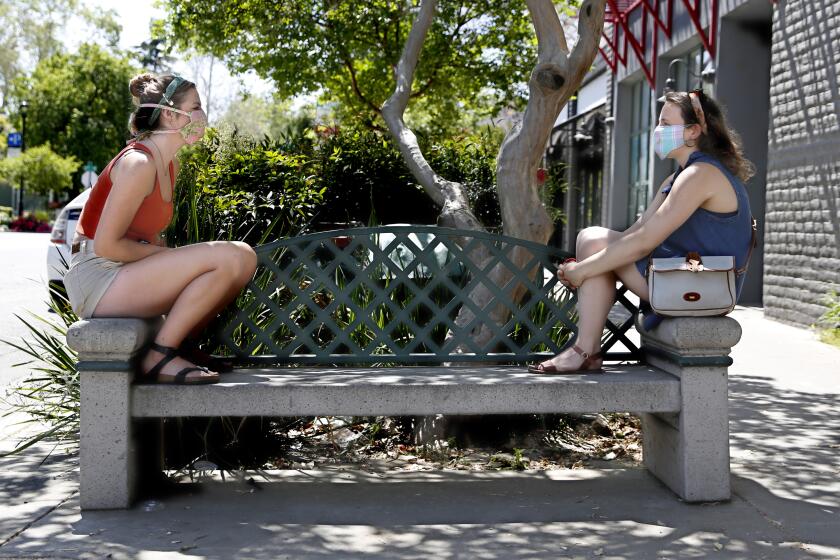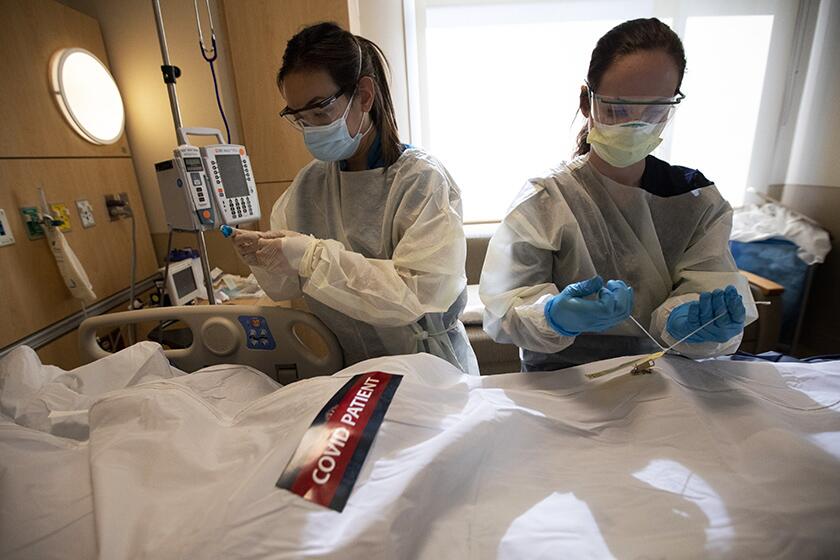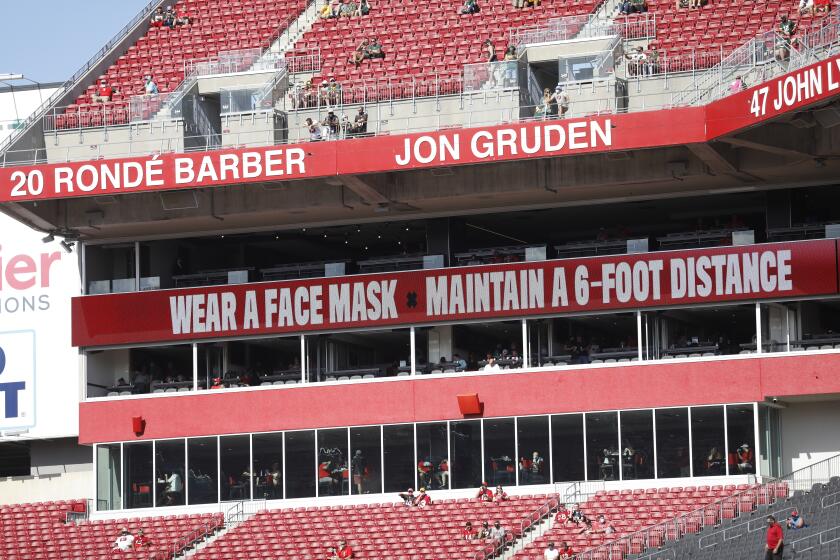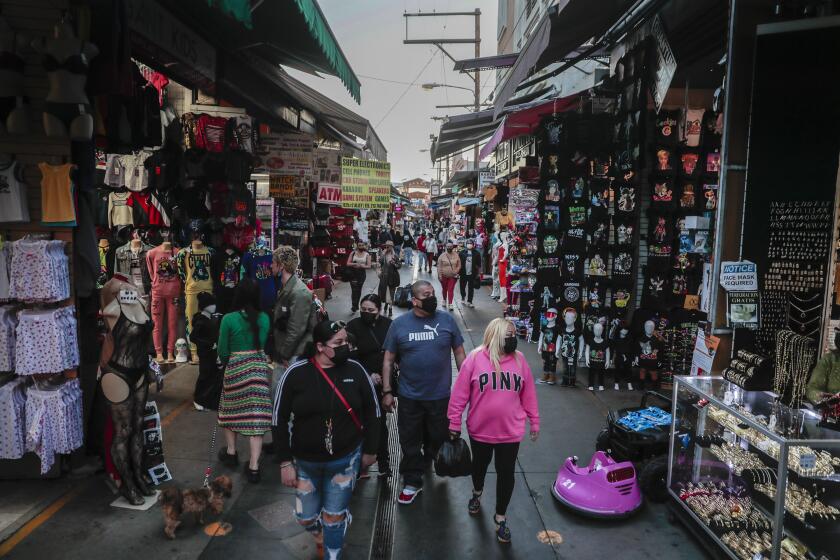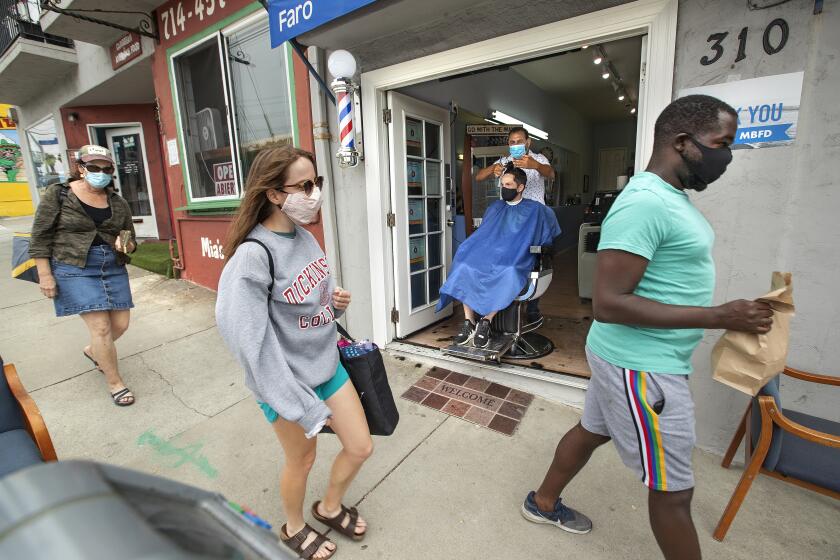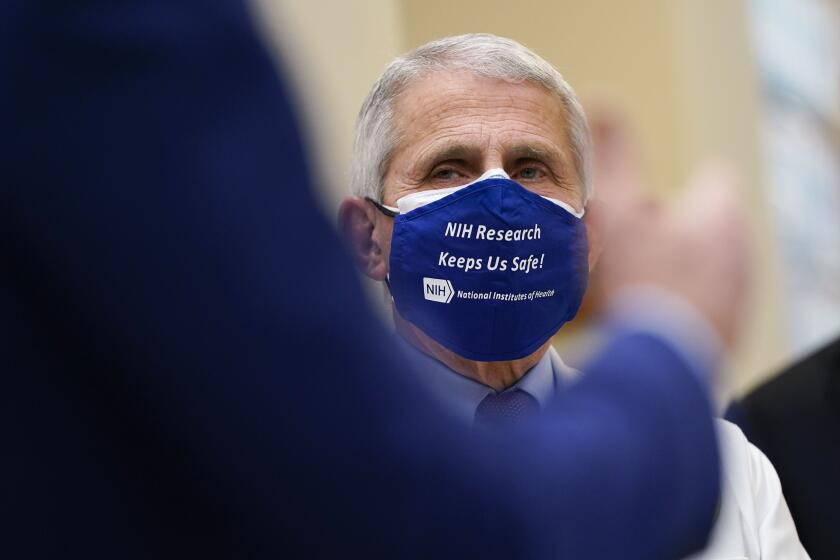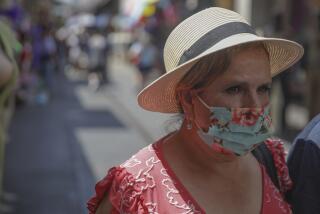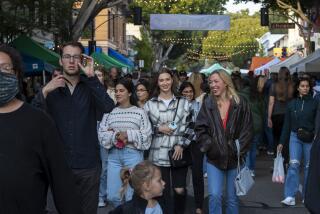What the road map for reopening California after COVID-19 surge looks like
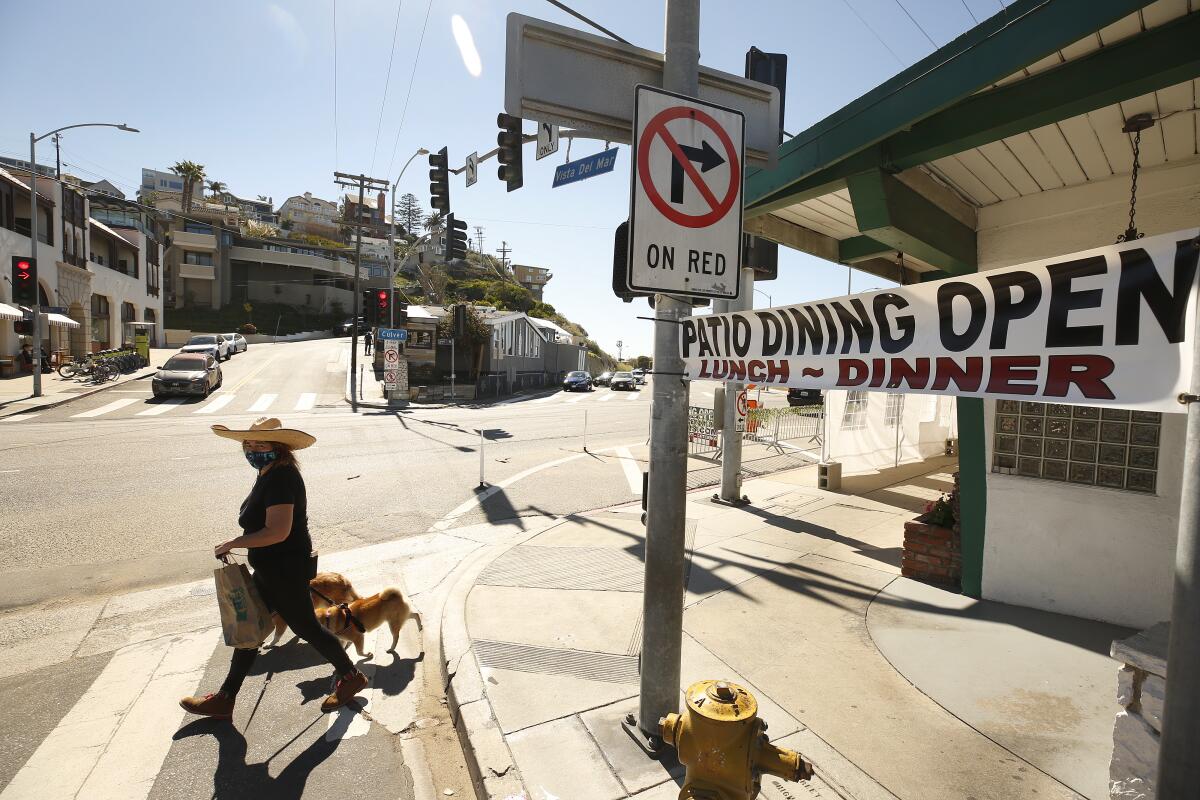
- Share via
California is beginning to reopen as the winter surge of COVID-19 continues to decline.
But it’s going to be a methodical process, guided by changes in geographic areas and involving a slow return of various activities, venues and businesses.
Several counties could be eligible to resume indoor operations, but don’t expect changes in L.A. County anytime soon.
Progress and warning signs
California is recording about 7,000 new coronavirus cases a day now, down from 45,000 a day six weeks ago. The number of COVID-19 patients in California’s hospitals on Sunday was 6,569, down from a high of 21,936 recorded on Jan. 6.
The number of people in intensive care units statewide was 1,933 on Sunday, down 60% from its peak of 4,868 on Jan. 10 and at its lowest number since Dec. 1.
But there are warning signs that could slow progress or even cause spikes in cases.
Officials are bracing for the rise of more transmissible variants of the virus, including a California strain that looks increasingly dangerous.
Los Angeles County Health Services Director Dr. Christina Ghaly on Tuesday noted that this week could bring increases in cases resulting from gatherings over Super Bowl weekend.
“An increase in the behaviors that facilitate transmission can still very easily lead to an uptick in the number of hospitalized patients in just a couple of weeks,” Ghaly said. “This can happen very quickly, and as we all know, it’s very difficult to then turn things around and start to force those numbers back down.”
California’s coronavirus strain is more transmissible than its predecessors, is more resistant to vaccines and may cause more severe cases of COVID-19.
Reopenings continue
On Tuesday, state officials announced that five California counties will be eligible on Wednesday to leave the most restrictive, or purple, tier to enter the second-most restrictive, or red, tier. Those counties are San Mateo, Marin, Yolo, Shasta and Humboldt.
If trends continue to improve, seven other counties could be eligible to transition next week from the purple tier to the red tier. They are Santa Clara, San Francisco, San Luis Obispo, El Dorado, Napa, Lassen and Modoc counties. And Sierra County, which is in the second-least restrictive, or orange, tier, could enter the least restrictive, or yellow, tier next week.
Southern California was hit much harder by the winter wave than other parts of the state, so reopenings are likely going to be slower there, officials have said.
L.A. County and California are seeing promising declines in coronavirus cases and hospitalizations, but progress remains precarious and could be eroded, officials say.
Here’s a review of what all the color-coded tiers mean:
- Purple, Tier 1, widespread transmission: Indoor operations of restaurant dining rooms and gyms are shut.
For counties in the purple tier, California officials require that the following types of indoor settings be closed to the public: restaurant dining rooms; wineries; gyms; saunas and steam rooms; dance and yoga studios; swimming pools; movie theaters; museums; zoos; aquariums; family entertainment centers like bowling alleys and escape rooms; indoor playgrounds like bounce centers, ball pits and laser tag facilities; offices in nonessential businesses; card rooms; and satellite wagering sites.
Houses of worship can open indoors at a maximum of 25% capacity. Most retail stores, malls and libraries can open at 25% capacity; grocery stores can open at 50% capacity. At indoor malls, common areas and food courts must be closed.
Closed to the public are amusement parks. Also closed are bars, breweries, and distilleries where no meals are provided — regardless of whether the settings are indoor or outdoor.
Professional sports venues and racetracks can operate but must be closed to in-person audiences.
Wedding ceremonies, funerals and other cultural ceremonies can be held indoors at a maximum of 25% capacity. Wedding receptions are banned statewide, regardless of the tier.
Higher-education institutions are closed for indoor lectures and student gatherings, but there are exceptions, such as for labs and studio arts.
Even though daily coronavirus case counts are tumbling, Los Angeles County has now recorded 20,000 COVID-19 deaths.
- Red, Tier 2, substantial transmission: Indoor restaurant dining rooms and gyms can open at limited capacity.
For counties in the red tier, indoor restaurant dining rooms and movie theaters can reopen at 25% capacity or up to 100 people, whichever is fewer. Gyms and dance and yoga studios can open at 10% capacity. Museums, zoos and aquariums can open indoor activities at 25% capacity.
Houses of worship can open indoors at 25% capacity. Stores, indoor malls and libraries can open at 50% capacity. Indoor malls must keep common areas closed and reduce capacity at food courts.
Closed to the public are amusement parks. Also closed are bars, breweries, and distilleries where no meals are provided — regardless of whether the settings are indoor or outdoor.
Wedding ceremonies, funerals and other cultural ceremonies can be held indoors at 25% capacity. Wedding receptions are banned.
Higher-education institutions can allow for indoor lectures and student gatherings but are limited to 25% capacity or 100 people, whichever is fewer; however, student activities should be held virtually when possible. Some courses in certain indoor settings, like labs and studio arts, may be open at regular capacity.
- Orange, Tier 3, moderate transmission: Bars can open outdoors; fans can return to outdoor professional sports venues at a limited capacity.
Indoor restaurant dining rooms and movie theaters can open at 50% capacity or 200 people, whichever is fewer; wineries can operate indoors at 25% capacity or 100 people, whichever is fewer. Bars, breweries and distilleries that don’t serve meals can open outdoors.
Houses of worship can open indoors at 50% capacity. Gyms and dance and yoga studios can open at 25% capacity; indoor swimming pools can open. Museums, zoos and aquariums can open indoor activities at 50% capacity.
Family entertainment centers like bowling alleys and escape rooms, and indoor playgrounds like bounce centers, ball pits and laser tag facilities, can reopen indoors at 25% capacity. Offices in nonessential industries can reopen, but workers should be encouraged to work remotely. Card rooms and satellite wagering sites can reopen indoors at 25% capacity.
Wedding ceremonies, funerals and other cultural ceremonies can be held indoors at 50% capacity. Wedding receptions are banned.
Retail and grocery stores and libraries can operate at full capacity. Indoor malls’ common areas remain closed, and food courts must operate at a reduced capacity.
Higher-education institutions can allow indoor lectures and student gatherings at 50% capacity or 200 people, whichever is fewer. Labs and studio arts can open at regular capacity; however, student activities should be done remotely when possible.
Small amusement parks can reopen outdoor attractions to in-county visitors at 25% capacity or 500 people, whichever is fewer, and must require reservations or advance tickets. (Small parks are defined as those with a total capacity of fewer than 15,000.)
Outdoor professional sports venues and racetracks can open at 20% capacity; fans must live within 120 miles of the venue and are required to have reservations and assigned seating; concessions are in-seat only.
Dr. Anthony Fauci, the nation’s coronavirus czar, says it’s possible masks could be needed for another year.
- Yellow, Tier 4, minimal transmission: Large theme parks can reopen at limited capacity, as can indoor operations of bars.
Indoor restaurant dining rooms, movie theaters, houses of worship, gyms, fitness centers, saunas, spas, steam rooms, dance and yoga studios, card rooms and satellite wagering sites can open at 50% capacity. Wineries can open indoors at 50% capacity or 200 people, whichever is fewer.
Indoor family entertainment centers, including arcades, ice skating rinks and playgrounds, can reopen at 50% capacity.
Indoor malls’ common areas can reopen, but food courts must operate at a reduced capacity. Museums, zoos and aquariums can open indoors at full capacity but must follow modifications.
Bars, breweries and distilleries that don’t serve meals can reopen indoors at 50% capacity.
Outdoor professional sports venues and racetracks can open at 25% capacity; fans must live within 120 miles of the venue and are required to have reservations and assigned seating; concessions are in-seat only.
Wedding ceremonies, funerals and other cultural ceremonies can be held indoors at 50% capacity. Wedding receptions are banned.
Higher-education institutions can allow for indoor lectures and student gatherings at 50% capacity. Labs and studio arts can open at regular capacity; however, student activities should be done remotely when possible.
Large amusement and theme parks can open at 25% capacity and must require reservations or advance tickets.
Statewide restrictions
Some venues are shut statewide for all tiers: concert venues, live theater, convention centers, festivals and nightclubs.
The state allows the following settings to remain open in all counties, regardless of the tier, with modifications to protect against the pandemic: body waxing studios, child care centers, day camps, doctor and dentist offices, electrologists, estheticians, farmer’s markets, film and TV productions, hair salons, barbershops, laundromats, massage therapy studios, music productions, nail salons, outdoor playgrounds, pet grooming, piercing shops, skateparks, skin-care services, outdoor swimming pools and tattoo parlors.
Large gatherings are generally prohibited statewide, with some exceptions, such as religious gatherings and protests as long as attendees wear masks and can maintain distance of at least six feet from members of other households.
Singing, shouting, chanting, cheering or exercising are strongly discouraged.
In the purple tier, small gatherings are allowed outdoors but require masks and physical distancing, attendance by members of no more than three households and a time limit of two hours.
The same types of gatherings may occur indoors in the less-restrictive tiers but are strongly discouraged.
“If gathering indoors, increase fresh air circulation by opening windows or doors, as much as possible, especially in the rooms where people are gathering,” state officials say.
Travel advisory
The California Department of Public Health in an advisory recommends that Californians avoid nonessential travel to any part of the state more than 120 miles from their place of residence or to other states or countries. Nonessential travelers from other states or countries are also strongly discouraged from entering California and are asked to adhere to quarantine protocols.
Nonessential travel is defined as travel for tourism or recreation.
State officials say anyone arriving in or returning to California from other states or countries should self-quarantine for 10 days after arrival, meaning they should stay at home and have food delivered. Those exempted from the quarantine advisory include healthcare workers and emergency responders engaged in essential work, and people who routinely cross state or national borders for essential travel.
Some counties have ordered mandatory 10-day quarantines for travelers.
L.A. County has ordered all persons arriving from other states or countries to quarantine for 10 days after arrival, with exceptions for emergency responders and workers meeting urgent healthcare staffing needs and people who routinely cross state and national borders for essential travel.
“If you do travel into Los Angeles County from outside of California, you need to self-quarantine for 10 days after you arrive and must limit your interactions to people in your household/people with whom you live. If you travel into Los Angeles County solely for essential work purposes, you need to still self-quarantine outside of your work for 10 days and ensure you do not mix with others outside of those necessary to conduct your essential work,” officials say.
Santa Clara County has also ordered mandatory quarantines for travelers from outside the Bay Area. San Francisco on Tuesday lifted its mandatory quarantine for travelers coming to the city, but still advised against nonessential travel from anywhere 120 miles away, which includes Lake Tahoe, Big Sur, Mount Shasta and Los Angeles.
“Lifting this order does not mean that it’s now safe to just hop on a plane or go on a road trip,” San Francisco acting health officer Dr. Susan Philip said in a statement. “This is not a travel free-for-all. We’ve made tremendous progress and brought our case numbers down, but we need to keep our guards up. The growing prevalence of variants, some of which were brought from abroad, is further proof that we must be extra cautious. If we do everything we are supposed to — wear our masks, practice physical distancing, avoid indoor gatherings with other households — we can continue to reopen businesses, schools and community activities. Voluntarily quarantining after traveling out of state or 120 miles from home helps protect everyone.”
More to Read
Sign up for Essential California
The most important California stories and recommendations in your inbox every morning.
You may occasionally receive promotional content from the Los Angeles Times.
